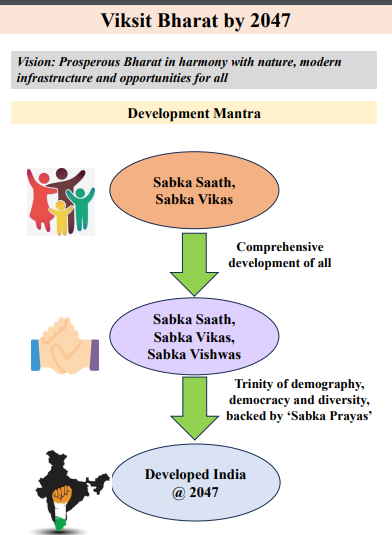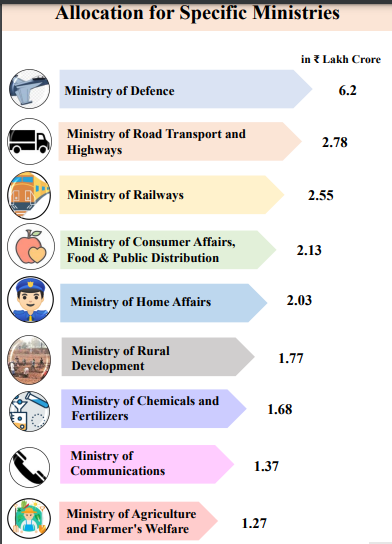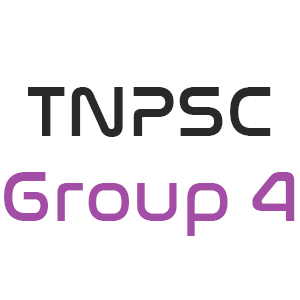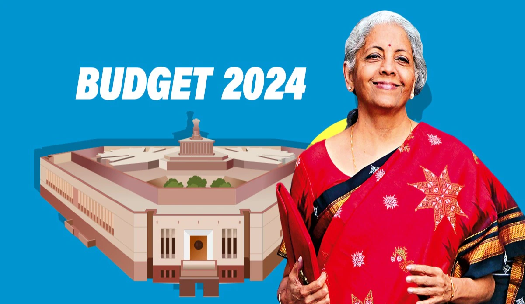Interim Budget 2024-Key Highlights- Explained Pointwise
Union Finance Minister, Nirmala Sitharaman, presented the Interim Budget 2024. The Interim budget that the finance minister presented today will stay valid for the first four months of the new fiscal year that starts in April. The comprehensive budget for the fiscal year 2024-2025 will be presented in July 2024.

| Table of contents |
| What are the key highlights of the Interim Budget? Macro-economic Highlights Infrastructure Highlights Green Energy Highlights Agriculture Highlights Research and Development Difference Between Annual Budget and Interim Budget |
What are the key highlights of the Interim Budget?
Macro-economic Highlights
1. Budget Estimates 2024-25-
| Total receipts other than borrowings | 30.80 lakh crore |
| Tax receipts | 26.02 lakh crore |
| Total expenditure | 47.66 lakh crore |
2. Fiscal Deficit- The estimated fiscal deficit in 2024-25 is set to be 5.1 per cent of GDP. The revised fiscal deficit is at 5.8% of the GDP for 2023-24 (FY24). These fiscal deficit trends adhere to the path of reduction of fiscal deficit below 4.5 per cent by 2025-26.
3. Lower borrowings by the Central Government- The gross and net market borrowings through dated securities during 2024-25 are estimated at 14.13 and 11.75 lakh crore respectively. The borrowings by the Central Govt are set to reduce in 2024-25 as compared to 2023-24. The lower borrowings by the central government will facilitate larger availability of credit for the private sector.
4. Continuation of the Fifty-year interest free Loan for Capital Expenditure to states- The scheme of fifty-year interest free loan for capital expenditure to states will be continued this year with total outlay of 1.3 lakh crore.
5. No changes to income tax slabs- No changes have been introduced in the income tax slabs.
6. Extension of Tax Exemptions- Tax exemptions given to start-ups extended till March 31, 2025.
7. Withdrawal of Direct Income Tax Demands- Government has decided to withdraw outstanding direct tax demands up to Rs 25,000 for the period up to financial year 2009-10 and up to Rs 10,000 for financial years 2010-11 to 2014-15.
8. Increase in Income Tax Filers and Income tax Collection- The number of tax filers have increased by 2.4 times. The direct tax collection has trebled since 2014.
Infrastructure Highlights
1. Increase in Capital Expenditure Outlay for Infrastructure- The Capital Expenditure outlay for Infrastructure for 2024-25 has been increased by 11.1 per cent to eleven lakh, eleven thousand, one hundred and eleven crore rupees (11,11,111 crore). This would be 3.4 per cent of the GDP.
2. Major economic railway corridor programmes- Energy, mineral and cement corridors, port connectivity corridors have been announced which will result in decongestion of the high-traffic corridors. These will help in improving operations of passenger trains.
3. Expansion of Pradhan Mantri Awas Yojana- Gramin (PMAY-G)- 2 crore more houses will be built under the Pradhan Mantri Awas Yojana-Gramin (PMAY-G).
4. Rooftop solarization and muft bijli– Through rooftop solarization, one crore households will be enabled to obtain up to 300 units free electricity every month.
Green Energy Highlights
1. Viability Gap Funding for Offshore Wind- Viability gap funding will be provided for harnessing offshore wind energy potential for initial capacity of one giga-watt.
2. Coal Gasification and liquefaction Plant- Coal gasification and liquefaction capacity of 100 MT will be set up by 2030. This will also help in reducing imports of natural gas, methanol, and ammonia.
3. Phased mandatory blending of CBG in CNG and PNG- Phased mandatory blending of compressed biogas (CBG) in compressed natural gas (CNG) for transport and piped natural gas (PNG) for domestic purposes will be mandated.
4. New Schemes for Bio-Manufacturing and Bio-Foundry- A new scheme of bio-manufacturing and bio-foundry will be launched. This will provide environment friendly alternatives such as biodegradable polymers, bio-plastics, bio-pharmaceuticals and bio-agri-inputs.
Agriculture Highlights
1. Agriculture and food processing- Promotion of private and public investment in post-harvest activities including aggregation, modern storage, efficient supply chains, primary and secondary processing and
marketing and branding.
2. Nano DAP- Application of Nano DAP on various crops will be expanded in all agro-climatic zones.
3. Atmanirbhar Oil Seeds Abhiyan- A strategy to achieve ‘atmanirbharta’ for oil seeds such as mustard, groundnut, sesame, soybean, and sunflower will be formulated.
4. Dairy Development- A comprehensive programme for supporting dairy farmers will be formulated. The programme will be built on the success of existing schemes such Rashtriya Gokul Mission, National Livestock Mission, and Infrastructure Development Funds for dairy processing and animal husbandry.
5. Matsya Sampada- Implementation of Pradhan Mantri Matsya Sampada Yojana (PMMSY) will be stepped up to enhance aquaculture productivity from existing 3 to 5 tons per hectare, double exports to 1 lakh crore and generate 55 lakh employment opportunities in near future. Five integrated aquaparks will be setup.
Research and Development
1. Corpus of Rs. 1 lakh crore- A corpus of rupees one lakh crore to encourage the private sector to scale up research and innovation significantly in sunrise domains.
Allocation Ministry Wise

Difference Between Annual Budget and Interim Budget
| Annual Budget | Interim Budget |
| The annual budget covers all aspects of government finances, including revenue generation, expenditure allocations, and policy announcements | The interim budget focusses primarily on maintaining essential spending on ongoing schemes and critical public services until the new government takes charge. |
| An annual budget, presented on February 1st of each year and outlines the government’s financial roadmap for the entire fiscal year (April 1 to March 31). | An interim budget, also known as a ‘Vote on Account‘, which is presented in an election year. It is essential government operations funded until the newly elected government presents its full budget. |
| Major Policy decisions like changes in tax structure, import duty Structure are announced in the annual budget. | An interim budget avoids major policy pronouncements or significant changes to tax structures due to its transitory nature. |
| The annual budget faces rigorous parliamentary debates and analysis. | Interim budget receives less scrutiny due to its limited scope and temporary nature. |
Budget 2024 – முக்கிய அறிவிப்புகள் என்னென்ன?
Important Links:
Text BOOK For Competitive Exams
Previous Year Question Papers Download
Tamil Nadu Government Exam Notes:
- Mental Ability Test Book PDF
- TNPSC (GROUP 1,2,2A) Preliminary UNIT VIII ( ii. Thirukkural) material free download
- TNPSC Exam Materials (Group 1,2,2A) – Tamil Nadu Commissionerate of Employment & Training
- TNPSC Group 2, 2A Model Test Paper 2021- Tamil Nadu Government
- TNPSC Group 4 Exam Free Government Material PDF Download All subjects | Tamil and English Medium
- TNPSC GROUP 2 2a Exam Free Government Material PDF Download All subjects | Tamil and English Medium
- TNPSC GROUP 1, 2, 2a, 4 Exam Free Government Material PDF Download All subjects | Tamil and English Medium
TNPSC Previous year question papers collections in single PDF
Mental Ability
- simple Interest
- Compound Interest
- LCM & HCF
- Percentage
- Mensuration 2D
- Mensuration 3D
- Profit & Loss
- Ages
- Ratio
- Simplification
- Statistics & Probability
- Time & Work
- TNPSC பொதுதமிழ் Previous year question with Answer combined pdf
- TNPSC Previous year Question paper 2020 – All exam Question and Answer in One pdf
- TNPSC PREVIOUS YEAR QUESTION PAPERS (2013 TO 2020) – History, Botony, Zoology, Physics, Chemistry, Polity, Economics
Other Important Links:
RRB RAILWAY RECRUITMENT BOARD (RRB NTPC) material free download
Tags:


